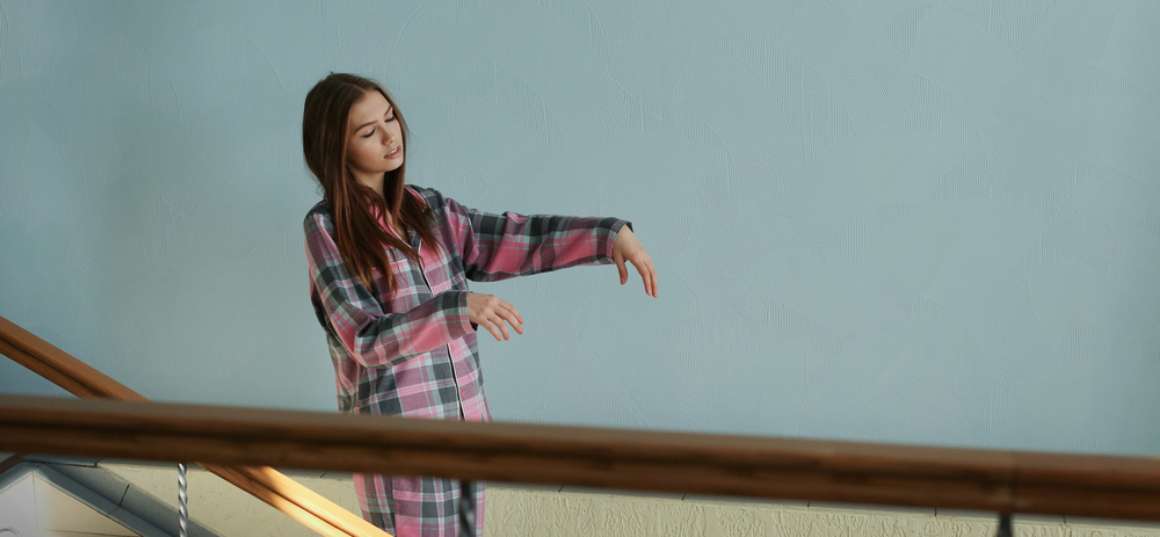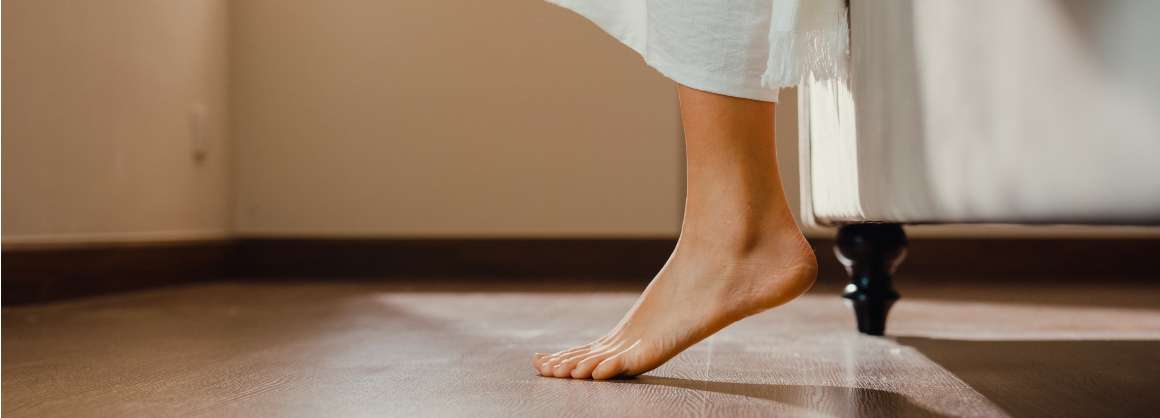Sleep Walking : Causes, Prevention, and Treatment
Published:
When it comes to sleepwalking, many people remain mystified by this nocturnal phenomenon. Sleepwalking occurs during poorly regulated deep sleep and can lead to complex behaviors that the individual has no memory of upon waking. In this article, we will investigate the mysterious realm of sleepwalking and provide useful information on its causes, effects, and management approaches.
Contents:
We'll explore common symptoms associated with sleepwalking episodes and their connection to non-rapid eye movement (NREM) arousal disorders. Furthermore, we will discuss genetic factors influencing somnambulism as well as environmental triggers that may provoke sleepwalking in certain individuals.
Finally, you'll learn about preventing sleep walking episodes through proper sleep hygiene practices and creating a relaxing bedroom environment. For those who are already experiencing this fascinating yet potentially disruptive condition, we offer guidance on how cognitive-behavioral therapy (CBT) can help stop sleepwalking along with long-term effects and management strategies for adult sufferers.

Understanding Sleepwalking
Sleepwalking, or somnambulism, is a behavior disorder that occurs during deep sleep and can last for a few seconds to half an hour. It arises from non-rapid eye movement (NREM) sleep arousal disorders and is more common in children than adults. Symptoms include sitting up in bed, walking around while asleep, looking dazed or confused, displaying clumsy behavior, and even urinating in undesirable places.
Common Symptoms of Sleepwalking
- Sitting up in bed while asleep
- Walking around the house with no awareness of surroundings
- A blank facial expression or glassy-eyed stare
- Inability to respond appropriately when spoken to by others
- Performing complex behaviors such as cooking or driving without waking up fully
Sleep medicine experts estimate that about one percent of people sleepwalk regularly, but many cases go unreported because the person may not remember their actions upon waking. Children are more likely to experience this phenomenon due to poorly regulated deep sleep cycles; however, adult cases do exist.
The Connection Between NREM Sleep Arousal Disorders and Sleepwalking
NREM (non-rapid eye movement) comprises three stages: light slumber transitioning into deeper restorative phases before entering REM (rapid eye movement). The third stage is characterized by slow brain waves called delta activity responsible for rejuvenating physical health throughout the night.
Sleepwalking episodes typically occur during these periods where there's an abrupt transition between different levels within this spectrum - particularly if someone experiences disruptions like noise disturbances outside their bedroom window causing them to stir momentarily before drifting back off again without fully awakening.
During this period, the body can remain active while the brain remains in a deep sleep state. This can lead to complex behaviors like walking around or even engaging in potentially dangerous activities with no conscious awareness of what's happening.
Studies have shown that people who experience frequent episodes of sleepwalking often suffer from other NREM disorder symptoms such as excessive daytime sleepiness and nighttime awakenings due to obstructive sleep apnea or restless leg syndrome. Addressing these underlying issues could help reduce instances where someone engages in unconscious actions during their slumber period by promoting more restful uninterrupted nights overall - ultimately benefiting everyone involved including bed partners who might be disturbed by such occurrences themselves.
Sleepwalking is an intricate matter, and comprehension of its origins and manifestations can aid in handling it. Causes of sleepwalking are believed to be linked to both genetic factors as well as environmental triggers; further research into these areas may provide insight on how best to prevent or treat this condition.

Causes of Sleepwalking
Sleepwalking, also known as somnambulism, is a complex behavior that can arise from various factors. Some individuals may be more prone to sleepwalking due to genetic predispositions or environmental triggers. Understanding these causes can help manage and prevent sleepwalking episodes.
Genetic Factors Influencing Sleepwalking
A hereditary component has been identified in some cases of sleepwalking. Research indicates that the likelihood of sleepwalking increases when a person has family members with histories of sleep disorders, including terrors and apnea, especially if both parents are affected. In fact, the likelihood increases if both parents have a history of this non-rapid eye movement (NREM) disorder.
Moreover, studies have shown that identical twins are more likely to exhibit similar patterns of sleep deprivation-induced behaviors, such as poorly regulated deep sleep leading to somnambulism. This suggests that genetics play an essential role in determining who might develop this condition.
Environmental Triggers for Somnambulism
Beyond genetic factors, certain environmental conditions can provoke or exacerbate instances of somnambulism:
- Lack of proper restorative slumber: Insufficient or disrupted deep (NREM) sleep cycles may increase the risk for engaging in complex behaviors like walking while asleep.
- Mental stressors: Anxiety-provoking situations can contribute to nighttime arousal during non-rapid eye movement stages and trigger episodes among susceptible individuals.
- Fever-induced stress: Illnesses accompanied by high fevers can lead to sleepwalking, as the body's systems struggle to maintain proper restorative functions.
- Medications: Some medications, such as sedative-hypnotics and certain antidepressants, may induce or exacerbate sleepwalking episodes. Consult your healthcare provider if you suspect that a medication is contributing to somnambulism.
- Migraines and head injuries: Neurological disruptions caused by migraines or past head trauma might increase the likelihood of engaging in unconscious activities during deep sleep stages.
In addition to these factors, other conditions like excessive daytime sleepiness due to narcolepsy or obstructive sleep apnea can also contribute indirectly. These disorders disrupt normal sleeping patterns and may result in an increased risk for experiencing nighttime arousal leading to somnambulism.
To better understand individual susceptibility and manage potential triggers effectively, it is crucial for those who experience regular episodes of sleepwalking to consult with a specialist in sleep medicine. Early intervention can help prevent further complications associated with this complex behavior disorder.
Sleepwalking can have a multifaceted origin, being the consequence of both genetic and environmental elements. Understanding the potential causes of sleepwalking is essential in order to address this condition effectively. Moving on, we will now explore the consequences of adult-onset somnambulism and what risks may arise from leaving it untreated.

Consequences of Adult Sleepwalking
Sleepwalking in adults can have serious consequences, impacting their health and overall quality of life. A study conducted from June 2007 to January 2011 found that adult sleepwalkers may experience violent behaviors during episodes, posing risks to themselves and others.
Frequency and Severity of Adult Somnambulism Episodes
The study revealed that out of the participants with a history of sleepwalking, 22.8% experienced nightly episodes while 43.5% had weekly occurrences. These frequent incidents not only disrupt the individual's sleep cycle but also pose potential dangers due to complex behaviors performed unconsciously during these episodes.
In addition to walking around while asleep, some adult sleepwalkers engage in activities such as cooking or driving without any recollection afterward. This lack of awareness increases the risk for accidents or injuries both for the person experiencing somnambulism and those around them.
Potential Risks Associated with Untreated Adult-Onset Cases
A staggering 58% of participants reported a history of violent actions during their unconscious state, highlighting the importance of addressing this underdiagnosed condition among adults. Potential risks associated with untreated adult-onset cases include:
- Injury: As individuals perform complex tasks without conscious control, they are more likely to hurt themselves or others unintentionally through falls or other accidents.
- Mental Health Issues: Chronic sleep deprivation resulting from frequent episodes can lead to excessive daytime sleepiness (EDS), anxiety, and depression.
- Relationship Strain: Sleepwalking can cause tension between the person experiencing it and their bed partner or family members due to disrupted sleep patterns and potential safety concerns.
- Sleep Disorders: Untreated somnambulism may be an indicator of other underlying sleep disorders such as obstructive sleep apnea or non-rapid eye movement (NREM) disorder that require medical attention.
To mitigate these risks, it is crucial for adult sufferers to seek professional help from a specialist in sleep medicine. Proper diagnosis and treatment can improve not only the individual's quality of life but also protect them from potentially dangerous situations arising during episodes. Early intervention can also prevent further complications associated with poorly regulated deep sleep, ensuring overall health and well-being.
In addition to seeking medical assistance, implementing healthy lifestyle changes such as maintaining a consistent bedtime routine, managing stress levels effectively, avoiding alcohol consumption before bedtime, and creating a safe sleeping environment are essential steps towards reducing the frequency of somnambulism episodes among adults.
The effects of grown-up sleepwalking can be severe and recurrent, so it is critical to take action in order to avert these events from happening. By establishing good sleep hygiene habits and creating a relaxing bedroom environment, individuals can reduce the risk of experiencing somnambulism episodes in adulthood.

Preventing Sleep Walking Episodes
To reduce the likelihood of experiencing sleepwalking episodes, it is essential to establish regular nap and sleep schedules, cut back on liquids before bedtime, avoid caffeine near bedtime, and ensure a relaxing environment conducive to restful slumber. By creating optimal conditions promoting healthy sleep habits, one can minimize their chances of engaging in unconscious activities while asleep.
Importance of Sleep Hygiene in Preventing Somnambulism
Sleep hygiene refers to practices that promote good quality sleep and daytime alertness. It plays a crucial role in preventing somnambulism as poor sleeping habits may lead to sleep deprivation, which can provoke sleepwalking episodes. According to the American Academy of Sleep Medicine (AASM), improving your overall sleep hygiene can help regulate your non-rapid eye movement (NREM) disorder.
- Maintain consistent bedtimes and wake-up times.
- Create a comfortable sleeping environment with minimal noise and light.
- Avoid heavy meals close to bedtime.
- Limit exposure to screens (TVs, smartphones) before going to bed.
- Incorporate relaxation techniques such as meditation or deep breathing exercises into your nightly routine.
Tips for Creating a Relaxing Bedroom Environment
An ideal bedroom should be conducive to restorative slumber by providing an atmosphere that promotes relaxation and minimizes disturbances during the night. This helps prevent poorly regulated deep sleep, which could trigger sleepwalking. Here are some tips to create a calming bedroom environment:
- Opt for slumber-inducing bedding materials that fit your inclinations, like foam mattresses or hypoallergenic cushions.
- Ensure the room temperature is cool and comfortable, ideally between 60-67°F (15-19°C).
- Use blackout curtains or shades to block out external light sources.
- Incorporate soothing scents like lavender essential oil in a diffuser for added relaxation benefits.
Taking these steps can help improve your overall sleep quality and reduce the chances of experiencing sleepwalking episodes. If sleepwalking persists despite following healthy sleeping habits, it may be beneficial to speak with a specialist in sleep medicine for further evaluation and potential treatments.
Sleepwalking can be prevented by practicing good sleep hygiene and creating a calming bedroom environment. CBT is a viable technique to treat sleepwalking in adults, and being aware of the enduring consequences of this disorder can assist you in devising more successful treatment plans.
How to Stop Sleepwalking
Fortunately, there are several methods available to help stop or reduce sleepwalking episodes. One such intervention method is cognitive behavioral therapy (CBT), which has been proven effective in treating various sleep disorders.
The Role of CBT in Treating Sleepwalking
CBT is a form of psychotherapy that works to identify and modify maladaptive thought patterns and behaviors associated with sleep disturbances, leading to improved sleep quality and decreased risk of somnambulism. By addressing these issues, individuals can improve their overall quality of sleep and reduce the likelihood of experiencing nighttime disturbances like somnambulism.
In some cases, CBT may involve relaxation techniques such as progressive muscle relaxation or deep breathing exercises designed to promote better sleep hygiene. Other components might include stimulus control therapy - where patients learn how to associate their bed with sleeping only - or establishing consistent bedtime routines that signal it's time for restorative slumber.
Long-term Effects and Management Strategies for Adult Sufferers
While most children tend to outgrow sleepwalking by their teenage years, some adults continue experiencing episodes throughout their lives. In these cases, long-term management strategies become essential not only for reducing incidents but also minimizing potential risks associated with adult-onset somnambulism.
- Maintain regular sleeping schedules: Going to bed at the same time every night helps regulate your body's internal clock, ensuring you get enough NREM sleep - the stage in which sleepwalking occurs.
- Create a safe sleeping environment: Remove any potential hazards from your bedroom and ensure that doors and windows are securely locked to prevent injuries or accidents during episodes.
- Avoid triggers: Certain factors like stress, alcohol consumption, or certain medications can provoke sleepwalking. Identifying these triggers and finding ways to manage them is crucial for reducing incidents.
- Consult with a healthcare professional: If your somnambulism persists despite self-help measures, it's essential to consult with a specialist in sleep medicine. They may recommend further evaluation or treatment options tailored specifically for you.
In addition to CBT and other management strategies mentioned above, it's important not to forget about the role of overall health in preventing sleep disorders. Ensuring proper nutrition, regular exercise, and managing stress levels can all contribute significantly towards achieving better quality restorative slumber - ultimately minimizing the risk of engaging in unconscious activities while asleep.
By understanding the role of CBT in treating sleepwalking, sufferers can develop long-term management strategies to reduce episodes. Concomitantly, alcohol consumption should be moderated to minimize the potential for exacerbating sleepwalking episodes.
Sleepwalking When Drunk
Alcohol consumption has been known to exacerbate or trigger sleepwalking episodes among individuals prone to somnambulism. This is due to its impact on the brain's ability to regulate proper sleeping patterns, increasing the likelihood that a person will engage in unconscious behaviors without any conscious awareness of what transpired afterward upon awakening.
The Impact of Alcohol on Sleepwalking Episodes
Alcohol affects various aspects of our sleep cycle, including disrupting REM and NREM sleep stages. As a result, alcohol can provoke sleepwalking by causing poorly regulated deep sleep (NREM disorder) and fragmented rest. Moreover, excessive daytime sleepiness caused by alcohol-induced poor-quality slumber may further increase the risk of engaging in complex behaviors like somnambulism.
In addition to disrupting normal sleeping patterns, alcohol also impairs cognitive functioning and coordination. This makes it more likely for intoxicated individuals who are already predisposed towards somnambulism to display clumsy behavior during their episodes. Furthermore, they might be at an increased risk for accidents or injuries as their judgment is impaired while under the influence.
Tips for Reducing the Risk of Somnambulism While Intoxicated
- Moderate your alcohol intake: Limiting your consumption can help reduce disruptions in your natural sleep cycle and decrease chances of triggering a sleepwalking episode.
- Avoid drinking close to bedtime: Giving yourself ample time between consuming alcoholic beverages and going to bed allows your body enough time to metabolize the substance before you enter deep NREM stages where most people sleepwalk.
- Establish a regular sleep schedule: Maintaining consistent bedtime and wake-up times can help regulate your body's internal clock, making it less likely for alcohol to disrupt your normal sleeping patterns. This is particularly important if you are prone to experiencing sleepwalking episodes.
- Create a safe environment: If you know that alcohol consumption increases the likelihood of sleepwalking, take precautions by removing any potential hazards from your surroundings before going to bed. This includes securing windows and doors or moving sharp objects out of reach.
- Talk to a medical professional: If you continue to experience sleepwalking incidents while intoxicated despite taking preventive measures, consult with a healthcare provider who specializes in sleep medicine for further evaluation and guidance on managing this condition effectively.
In conclusion, understanding the relationship between alcohol consumption and sleepwalking is crucial for individuals predisposed towards this behavior. By implementing these tips into their daily routines, they can minimize risks associated with intoxication-induced episodes while promoting overall health and well-being through better-quality slumber.
FAQs in Relation to Sleep Walking
What Causes Sleepwalking?
These may include a family history of sleep disorders, stress, irregular sleep schedules, certain medications or substances like alcohol, and underlying medical conditions such as sleep apnea.
What Are Three Common Causes of Sleepwalking?
Three common causes of sleepwalking include: (1) genetic predisposition - having a close relative who experiences the disorder; (2) external triggers - such as stress or medication side effects; and (3) disrupted sleeping patterns - which can be due to poor bedtime habits or an inconsistent schedule.
What Is the Latest Research Regarding Sleepwalking?
The latest research on sleepwalking focuses on understanding its neurobiological mechanisms and identifying potential treatment options. Recent studies suggest that abnormal brain activity during deep non-REM stages of sleep may contribute to this behavior while others explore how cognitive behavioral therapy could help manage it effectively.
Is Sleepwalking Caused by Trauma?
Sleepwalking is not directly caused by trauma, but experiencing traumatic events can increase the likelihood of developing this condition. Trauma-related stressors might disrupt normal sleeping patterns or exacerbate existing vulnerabilities in individuals prone to parasomnias like somnambulism.
Conclusion
Overall, sleepwalking is a common phenomenon that affects both children and adults. While the exact causes of sleepwalking are not fully understood, it can be managed through establishing healthy sleeping habits, creating a calming bedroom environment, guiding sleepwalkers back to bed safely, and seeking professional help when necessary.
To ensure safety and proper treatment, it is important to take action if you or someone you know experiences frequent episodes of sleepwalking. By following these tips and understanding the underlying factors contributing to sleepwalking behavior, individuals can better manage this condition for improved overall health and well-being.








